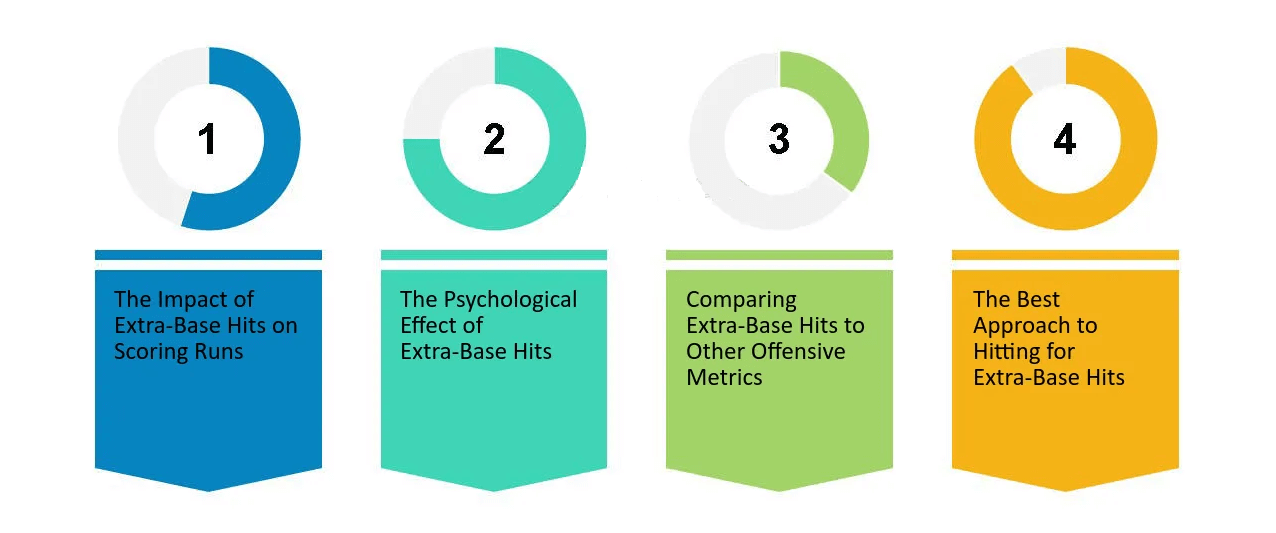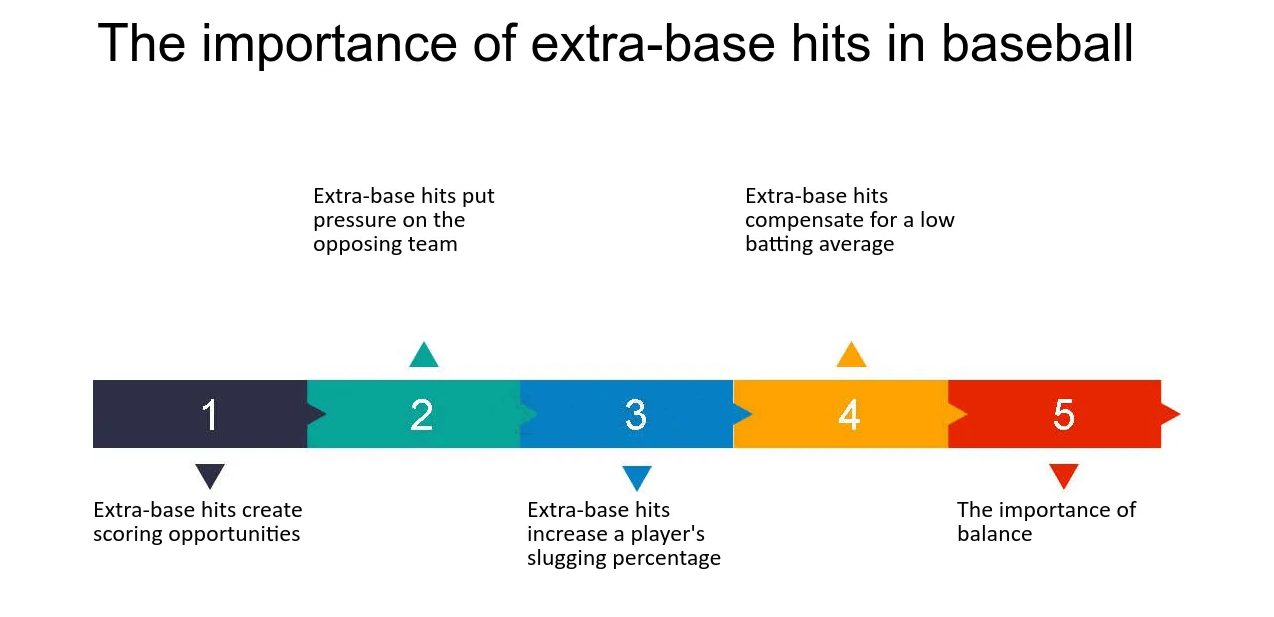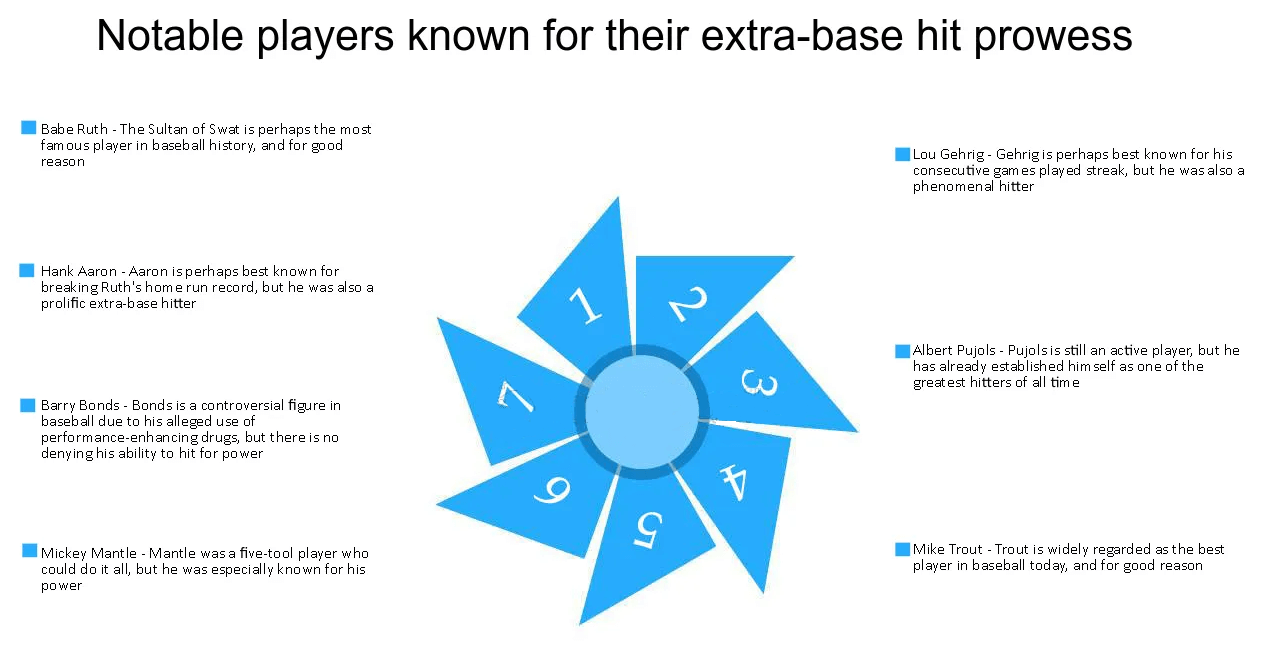An extra-base hit (XBH) in baseball is defined as any base hit where the batter is able to advance past first base without the help of an error or a fielder’s choice. This includes doubles, triples, and home runs. Extra-base hits are important in baseball because they allow batters to advance multiple bases on a single swing, often leading to runs scored. Teams that hit for more power and accumulate extra-base hits tend to score more runs.
Extra-base hits demonstrate a batter’s ability to drive the ball further and hit for power. They are considered more valuable offensive outcomes than singles. Tracking extra-base hits helps quantify a player or team’s power and overall offensive production.
In summary, extra-base hits are an integral component of baseball offense, allowing teams to manufacture big innings and outscore their opponents. This article will provide a comprehensive overview of extra-base hits in baseball.
Types of Extra-Base Hits

An extra-base hit in baseball is defined as any hit where the batter is able to advance beyond first base. There are three main types of extra-base hits:
-
Double: A double is an extra-base hit where the batter is able to reach second base. To record a double, the ball must make contact in fair territory and bounce before going over the fence or reach the wall allowing the batter to safely reach second base. Doubles provide a great opportunity to drive in runs as having a runner on second base puts them in scoring position 1.
-
Triple: A triple is an extra-base hit where the batter is able to reach third base. Typically, a triple occurs when the ball is hit into the outfield gap allowing the batter to reach third base before the ball can be returned to the infield. Triples are exciting plays that often drive in runs from second base and put the batter in scoring position at third base 2.
-
Home Run: A home run is an extra-base hit where the batter is able to touch all four bases and score a run. For a hit to be considered a home run, the ball must clear the outfield fence in fair territory without being caught for an out. Home runs are the most exciting extra-base hit, driving in all baserunners and scoring a run for the batter.
Extra-base hits are desired by batters because they provide more value than a single. Hitting for power and driving the ball for extra bases is an important offensive skill in baseball.
How Extra-Base Hits Happen
Extra-base hits occur when a batter hits the ball hard enough or places it well enough to advance past first base without the help of an error or fielder’s choice.
There are a few main ways extra-base hits happen in baseball:
Hard hit balls – One of the most common ways to get an extra-base hit is to simply hit the ball very hard. A line drive or hard ground ball that sails past fielders can result in a double or triple if hit hard enough. The exit velocity off the bat is key – the harder the ball is hit, the more likely it becomes an extra-base hit.
Balls hit in gaps or down the lines – Well placed hits between fielders or down the foul lines often result in extra bases. Hits that split the gap between outfielders or get past the infielders down the 1st or 3rd base lines give the batter time to reach second or third safely. Knowing how to place hits and hit to open areas of the field is an important skill.
Balls hit over the fence – The ultimate extra-base hit is the home run, which occurs when a batter hits the ball over the outfield fence in fair territory. Home runs are almost automatic extra-base hits, only resulting in a single if the ball bounces back into play or there is fan interference. Power hitters aim to drive the ball deep enough to clear the fence.
Importance of Power

Extra-base hits are a clear demonstration of a hitter’s power. While singles can advance runners, extra-base hits drive in more runs by moving runners further around the bases. The ability to consistently hit for extra bases is a highly sought after offensive skill. Teams loaded with power hitters who hit a high percentage of extra-base hits typically score more runs.
While batting average focuses on the ability to simply get on base, extra-base hits better indicate a hitter’s run-producing power. The total number of extra-base hits measures a hitter’s ability to hit for distance and drive the ball into the gaps. Winning teams need players who can drive in runs when given the opportunity. Extra-base hits provide the running start that forces runs across the plate. The importance managers place on power hitters underscores the value extra-base hits provide to an offense.
Leading Extra-Base Hitters
Hank Aaron holds the career record for extra-base hits with 1,477 over his 23-year career, well ahead of Barry Bonds (1,440) and Albert Pujols (1,405), the only other players with over 1,400 career extra-base hits. Aaron hit 855 doubles, 98 triples, and 524 home runs, demonstrating consistent power throughout his long career.
The single-season record for extra-base hits is 119, set by Lou Gehrig of the New York Yankees in 1927 as part of his legendary season where he hit 47 home runs and batted .373. Chuck Klein also hit 119 extra-base hits in 1930 while playing for the Philadelphia Phillies. More recently, Todd Helton hit 105 extra-base hits for the Colorado Rockies in 2000 during the peak of his power-hitting prime.
Extra-Base Hits and Slugging Percentage
Slugging percentage (SLG) is a popular statistic in baseball that measures a batter’s total bases per at-bat. It provides a sense of a hitter’s power by tracking extra-base hits.
Extra-base hits are vital for boosting a player’s slugging percentage. By hitting doubles, triples and home runs, batters can accrue significantly more total bases than with singles alone. This is why power hitters who frequently hit extra-base hits usually have high slugging percentages.
While a single counts as one total base, a double counts as two, a triple as three, and a home run as four. The more extra-base hits a batter gets, the higher their total bases, which increases their slugging percentage. Players want a high SLG because it demonstrates their ability to hit for power and drive the ball for extra bases. Teams desire players with power who can hit extra-base hits as they generate more runs.
Park Factors
Some ballparks are more favorable for hitting extra-base hits than others. This is due to the unique dimensions, weather, and elevation of each stadium. MLB uses a metric called Park Factors to quantify how each ballpark impacts extra-base hits relative to the league average.
Coors Field in Denver has the highest Park Factor for extra-base hits, meaning it boosts long hits more than any other stadium. The high elevation reduces air resistance on batted balls, helping them carry farther. Fenway Park and Great American Ball Park also rank near the top for Park Factors. Meanwhile, Oakland Coliseum and Citi Field suppress extra-base hits the most.
The weather, temperature, humidity, and other environmental factors also influence how far balls travel in each park. Retractable or closed roofs tend to boost offense. Day games played in hot weather lead to more extra-base hits as well.
In the end, Park Factors help explain why certain players perform better at some ballparks. Knowing the dimensions and typical conditions helps teams tailor their roster construction too. While the talent on the field matters most, some stadiums make it easier to hit for power.
Notable Extra-Base Hit Feats

Some of the most notable individual extra-base hit accomplishments in MLB history include:
-
In 1927, Babe Ruth set the single-season record for extra-base hits with 119, hitting 60 home runs along the way. This record stood for 34 years until it was broken by Stan Musial in 1948.
-
Stan Musial holds the MLB record for most career extra-base hits with 1,377 over his 22 year career from 1941-1963.
-
In 2001, Barry Bonds set a new single-season record by hitting 73 home runs, which greatly contributed to his career total of 1,440 extra-base hits, good for second all-time behind Musial.
-
The great Hank Aaron sits third all-time in career extra-base hits with 1,477. Aaron was a model of consistency, tallying at least 20 extra-base hits in every one of his 23 MLB seasons.
-
In 1930, Chuck Klein of the Philadelphia Phillies had 107 extra-base hits, which is the National League record for a single season.
-
The top 5 single-season extra-base hit totals in MLB history are held by Babe Ruth (119), Lou Gehrig (117), Chuck Klein (107), Todd Helton (105), and Hank Greenberg (103).
Extra-Base Hits in Popular Culture
Extra-base hits have made their way into popular culture over the years, with references in movies, TV shows, songs, and more. For example, Willie Mays, Ty Cobb, and Joe DiMaggio are mentioned in the lyrics of songs like Centerfield by John Fogerty and Talkin’ Baseball by Terry Cashman. Movies like The Sandlot, Field of Dreams, and A League of Their Own also feature memorable extra-base hit scenes.
TV shows like The Simpsons have made references to extra-base hits over the years as well. In one episode, when Bart hits an inside-the-park home run, the announcer refers to it as a “four-bagger,” a classic slang term for a home run. Extra-base hits are woven into the fabric of American pop culture. Whether it’s the crack of the bat or the excited calls of the announcers, extra-base hits create dramatic and memorable moments that resonate beyond just fans of the game.
Conclusion: The Significance of Extra-Base Hits
Extra-base hits have been an integral part of baseball since the early days of the sport. While singles and walks are important for getting on base and manufacturing runs, extra-base hits provide a sudden boost in offense that can change the complexion of a game in an instant.
The power to drive the ball for extra bases has always been a highly desired and rewarded talent in major league players. The legends of baseball history include prominent extra-base hitters like Babe Ruth, Hank Aaron, Barry Bonds, and Albert Pujols. In recent decades, there has been an increased emphasis on power hitting across the sport.
Analytics have further demonstrated the value of extra-base hits through metrics like slugging percentage and isolated power. Teams today closely analyze data to determine which players consistently produce extra-base hits and how home ballparks factor into power numbers. While baseball will always have room for the speedy singles hitter, the momentum-shifting magic of the extra-base hit ensures power hitters remain an integral part of the modern game.
In summary, hitting for extra bases has significantly influenced baseball strategy and shaped the history of the sport. For players and fans alike, the mighty thrill of the extra-base hit continues to captivate as much as ever. Their importance and mystique cement extra-base hits as one of the defining components that makes baseball America’s pastime.








